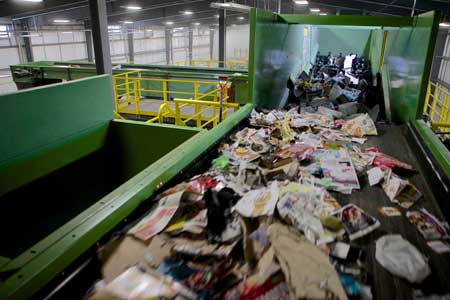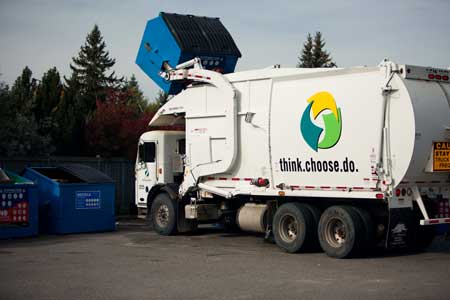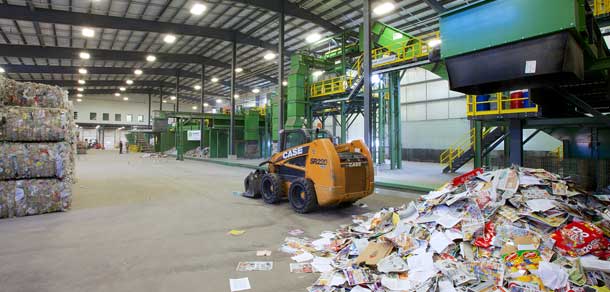For the record, cow heads cannot be recycled. “One of the biggest challenges in the recycling industry is sorting. People put an astonishing array of things into their recycle bins. For us, it isn’t ‘everything but the kitchen sink’. It’s literally everything including the kitchen sink. No joke, we once had a cow head come through the line,” says Tim Teeple, general manager for Emterra Environmental’s Saskatchewan operations.
Emterra, based out of Burlington, Ontario, provides a wide range of recycling and other waste diversion services to municipalities and businesses across North America. The familiar residential blue bins in Regina and surrounding communities are contracted to Emterra.
Eye Can’t Do It
Teeple has worked in the recycling industry for over 30 years. Over that time, the single biggest change he has seen has been the overwhelming growth in the volume and variety of recycled material as individuals, municipalities and businesses have become more engaged in the waste reduction effort. But this growth has also strained the ability of recycling facilities to keep up with demand.
“The simple fact is that the traditional methods of manual sorting of materials just aren’t feasible anymore. If you consider plastics alone, which have to be sorted into different types according to resin levels, the stream of product coming through a conveyor belt is going by so fast that it’s effectively impossible for the human eye to make those distinctions,” Teeple says.
Instead, Emterra now employs a single stream recycling system that automates the process.
“We still do some manual sorting to filter out some larger or obviously inappropriate objects. We also use conventional mechanical filtration techniques to take out small objects. From there, we use a system of optical sensors, pneumatic tubes and magnets to separate the materials,” says Nevil Davies, director of special project and process improvement at Emterra Group.
The automated sorting system, located at the Global Transportation Hub (GTH) in Regina, can disentangle everything from different types of plastic to paper to metal. The system typically allows Emterra to recover 20 to 25 per cent more recyclable material compared to systems where the consumer pre-sorts materials into different bins.
Setting the Example
 Emterra’s GTH facility is its newest and most state-of-the-art, putting the company at the top of the industry in resource recovery. Completed in 2013, it’s Emterra’s first facility built from the ground up to incorporate environmental sustainability. The 45,000 square foot plant follows Leadership in Energy and Environmental Design’s (LEED) best practices for the design, construction and operation of high-performance green buildings.
Emterra’s GTH facility is its newest and most state-of-the-art, putting the company at the top of the industry in resource recovery. Completed in 2013, it’s Emterra’s first facility built from the ground up to incorporate environmental sustainability. The 45,000 square foot plant follows Leadership in Energy and Environmental Design’s (LEED) best practices for the design, construction and operation of high-performance green buildings.
The facility is designed to process over 50,000 tonnes of recyclables each year. But it doesn’t just process recyclables. It uses them. In addition to its energy-saving aspects, some of its features include:
Recycled Asphalt: Over 250 metric tonnes of recycled asphalt were incorporated into the site development.
Green Windows: All aluminum components are made from approximately 50 per cent recycled materials.
Recycled Metal Structure and Panels: Nearly 137 metric tonnes of recycled steel is included in the structure and cladding systems.
The Glass Menagerie
One of the most difficult and, at times, controversial aspects of the recycling business is glass.
Hard fact: It doesn’t really get recycled.
“Just think about the journey a glass bottle makes from your house to the recycling facility. You toss it, probably pretty roughly, into the bin. Then it’s dumped into the collection truck where it’s compacted several times. Then it’s dumped out and shoved around on the floor of the processing facility,” Teeple says.
“We sometimes get whole, intact reusable glass containers that come through the line. We have a name for them. We call them ‘Miracle Glass’.”
The rest of the sharp chunks of shattered glass must be filtered out of the pile of recyclables before it goes into the single stream process.
“We call these glass ‘fines’ and they are removed through a series of conventional size-sorting filters. The trouble is that other objects of the same size get filtered out at the same time so what comes out the other end isn’t glass so much as it’s a mish-mash of trash with some glass in it,” says Davies.
Since no economical method has yet been found to extract the glass from this conglomeration, it is most commonly just sent to the landfill. Emterra and others in the industry continue to look for other applications for this material including “glasshphalt” road-coating material or as an aggregate to fill drill sites.
The Sword of Beijing
While most of the world today is focused on trade disputes with America, the recycling industry has found itself struggling with new Chinese regulations bearing the dramatic name National Sword.
China has traditionally been the world’s largest market for recyclable materials, especially paper and plastics. This market was assisted by relatively lax regulations about the treatment of mixed waste (i.e. garbage) in shipments of recyclables. Previously, Chinese buyers of recyclables used a system similar to the dockage system familiar to Saskatchewan farmers. There was a guideline for levels of mixed waste but, if the guideline was exceeded, the buyer would simply penalize the seller but still accept the shipment.
But the Chinese government has grown tired of accepting the world’s garbage so it has brought in strict new regulations. Under National Sword, the levels of acceptable mixed waste have been slashed dramatically. Further, the limits are enforced by government inspectors and shipments will be sent back if they fail to meet them.
“This has thrown the entire recycling industry into crisis. The targets the Chinese government have set are not really achievable. The industry is struggling to adapt. Recyclers who have long-term contracts with municipalities are trying to renegotiate those contracts to account for the higher processing costs. Materials that once had a market are now ending up in landfill,” Teeple says.
Emterra has a couple of advantages in facing this challenge. First, it was ahead of the curve in adopting optical scanning technology that helps reduce the level of mixed waste.
“We managed to acquire 10 of them early on. Today, the wait time for optical scanners is over 50 weeks,” Teeple says.
Emterra also has its own plastics recycling facility in Ontario that handles most of the materials it gathers from its North America-wide operations so it is not as dependent on the Chinese market for those products. Paper, on the other hand, remains a problem.
Consumers Are the Key
 Teeple and Davies deliver a message that is common throughout the waste management sector: effective recycling starts with the consumer.
Teeple and Davies deliver a message that is common throughout the waste management sector: effective recycling starts with the consumer.
“It isn’t just a matter of throwing everything into the big blue bin. It’s important for consumers to do a bit of a pre-sort by being knowledgeable about what kinds of materials can and can’t be recycled. It’s a small thing, but rinsing your recyclables well makes a huge difference. Unrinsed yogurt containers, for example, are a big headache for us because the yogurt gums up the machinery,” Teeple says.
“The goal for all of us is to keep material out of the landfill but we all have to work together to achieve that goal.”
